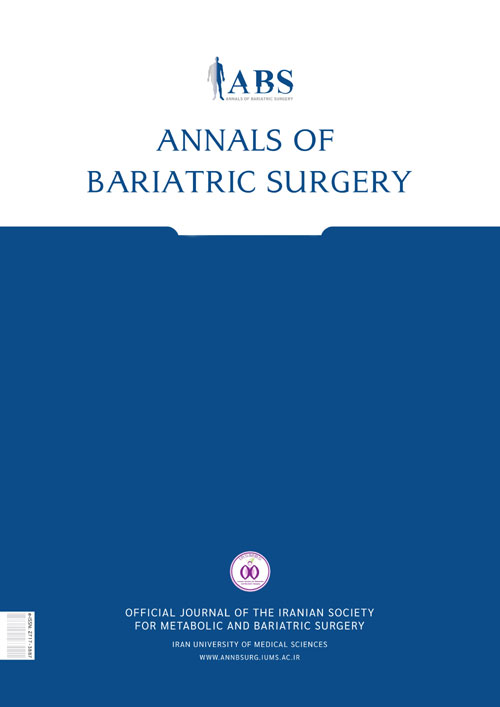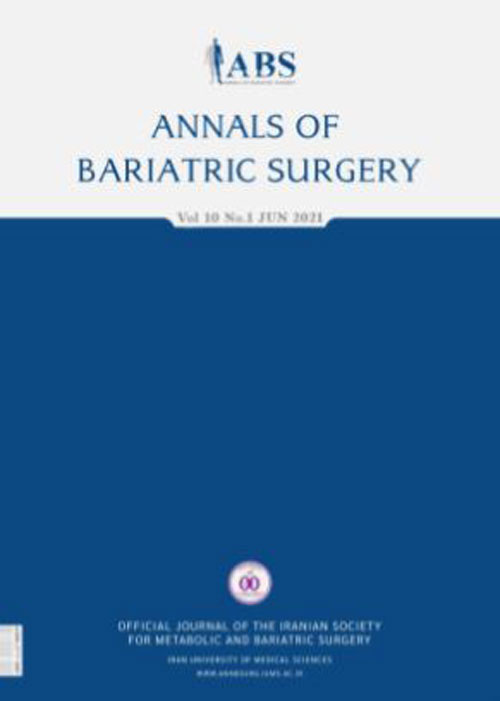فهرست مطالب

Annals of Bariatric Surgery
Volume:9 Issue: 2, Summer and Autumn 2020
- تاریخ انتشار: 1400/01/23
- تعداد عناوین: 6
-
-
Pages 1-8Background
Obesity is considered as an independent risk factor for type 2 diabetes (T2D) and other metabolic diseases. Obesity accounts for about 55% of diabetes. This study aimed to investigate the therapeutic effects of obesity surgery on glucose, HbA1C, insulin and C-peptide serum levels in the patients with T2D.
Methods and materials:
This prospective cohort study carried out on 25 patients aged between 18-70 years who had with T2D and body mass index above 40 kg /m2. Fasting blood sugar (FBS) level, HbA1C and Two-hour postprandial (2HPP), insulin level, and C-peptide were measured in all patients before surgery and the patients were fully evaluated for the presence of diabetes complications. The patients underwent Roux-en-Y Gastric Bypass (RYGB), mini-gastric bypass, and sleeve gastrectomy, and were re-evaluated 24 hours, one week, two month, and six months after surgery.
ResultsTwenty-five people underwent (sleeve gastrectomy for 12 cases, RYGB for 7 cases and mini-bypass surgery for 6 cases). Twenty cases (80.0%) were women and five cases (20.0%) were men. The mean age of the patients was 46.16 ± 10.97 years (25-67 years).The mean fasting blood sugar, 2HPP, HbA1C, insulin, and C-peptide in general and in all three groups showed a significant decrease.
ConclusionThe findings of the study showed that all three surgical procedures were effective in improving T2D by six months after surgery.
Keywords: Type 2 diabetes, obesity surgery, sleeve, mini bypass, classic bypass -
Pages 9-17Background
The aim of the present study is determination of association between dietary patterns, MDs and HEI with anthropometric and biochemical parameters in individuals with morbid obesity who are candidates of bariatric surgery.
MethodsParticipants of present study were adults with morbid obesity who candidate for bariatric surgery and have referred to the surgery clinic of Firoozgar Hospital. Ideal Body Weight and Adjusted Ideal Body Weight were calculated. The dietary data were collected using a Food Frequency Questionnaire (FFQ). Dietary patterns, MDs and HEI were calculated using FFQ data. Anthropometrics and biochemical parameters were assessed. All statistical analyses were done using SPSS. A p-value of <0.05 was considered significant.
ResultsHEI and MDs were negatively related to blood iron status. Moreover, these dietary indices were associated with ferritin level. In the case of HEI, this relationship was positive while negative for MDs. A significant correlation was seen between dietary pattern 1 with body mass index (BMI), total cholesterol and iron. Such a correlation was also seen between dietary patter 2 with Albumin. However, no correlation was seen between dietary pattern 3 with any of anthropometric and biochemical parameters.
ConclusionFinding of present study indicates that regardless of energy intake, diet quality plays a critical role in the metabolic health of body.
Keywords: dietary pattern, diet quality index, Mediterranean Diet score, Healthy Eating Index, Dietary Indices, bariatric surgery, obesity -
Pages 18-21
Laparoscopy begins with the safe creation of a pneumoperitoneum, often a difficult step in the bariatric patient. To minimize entry-related injuries, several techniques, instruments and approaches have been introduced during the last years. First Trocar insertion related Complications can occur even in the best of hands and it is vital that these are recognized promptly and immediately addressed. In our experience we use some steps in trocar entry to minimize trocar related abdominal injuries.
Keywords: Bariatric Surgery, Laparoscopy, Pneumoperitoneum, Trocar, visual entry system -
Pages 22-25Background
Patients who undergo sleeve gastrectomy are at risk for micronutrient deficiencies. The aim of this study was to investigate the changes of serum 25OH-vitaminD level in obese patients after sleeve gastrectomy.
MethodsThis retrospective study consisted of 952 patients (682 female and 272 male) who underwent bariatric surgery by a surgical team in Shiraz Mother and Child Hospital. Serum levels of 25OH-vitaminD before and three months after the surgery was evaluated.
Resultsthe results indicated that the mean of serum 25OH-vitaminD level in women ranged from 15.65±1.2 to 24.6±1.98 (P value=0.05) and in men from 15.65±1.2 to 26.72±2.33 (P value=0.02).
ConclusionsOur findings shows that bariatric surgery contributed to improve vitamin D deficiency after 3 months in obese patients undergoing sleeve gastrectomy, which indicate that good follow-up after surgery, can lead to improving the level vitamin D serum.
Keywords: Sleeve gastrectomy, 25OH-vitaminD, Obesity -
Pages 26-28Background
Weight loss after Bariatric surgery is extremely variable and genetically influenced. Genome-wide association studies (GWAS) have identified many single nucleotide polymorphisms (SNP) related to weight, body fat proportion and additionally feeding behaviors. Thus, the aim of this study was to research the effects of sequence variants and determined SNP on patient’s responses to bariatric surgery.
MethodsThis review article summarizes studies that were investigating the influence of genetic polymorphisms in different effectiveness of bariatric surgery and weight loss pathways. Scopus and PubMed database were consistently searched up to January 2021.
ResultsThe evidences from GWAS studies showed that many genes and SNPs affected the individual responses to bariatric surgery. the most of these SNPs is associated to genes that regulate the lipolysis/lipogenesis pathways, adipose cell metabolism, metabolic process chain, insulin resistance, insulin/glucagon metabolism, feeding behavior and appetite-sensing state. At this regard, rs16945088 SNP of FTO (fat mass and obesity-associated) sequence, MC4R (melanocortin 4 receptor), rs660339 (Ala55Val) SNP of uncoupling proteins 2 (UCP2), leptin receptor gene (Lys656Asn and Asn656Asn), gucagon-like peptide 1 receptor gene (rs6923761) and INSIG2 (insulin induced gene 2) are the most studied and affecting polymorphisms that have influence on bariatric surgery outcomes.
ConclusionGenetic background encompasses a important impact on weight loss after bariatric surgery. within the future, genetic testing could probably be employed in the pre-surgical assessment of patients with severe obesity for selecting the best surgery procedure for patients, avoiding supernumerary adverse effects and prices
Keywords: Obesity Surgery, Gastric Bypass, Single nucleotide Polymorphisms, Genome-Wide Association Studies, GWAS, SNP -
Pages 29-31
Laparoscopic sleeve gastrectomy (LSG) is the most bariatric procedure being performed for obesity surgery worldwide. Although the procedure learning curve seems not too long, some complications of LSG can be major and/or life-threatening. Among these, one “less appreciable” major complication is dysphagia that can happen easily if the surgeon does not follow the standard steps of performing LSG. Here, we present one such chronic complication after LSG.
Keywords: dysphagia, sleeve gastrectomy


